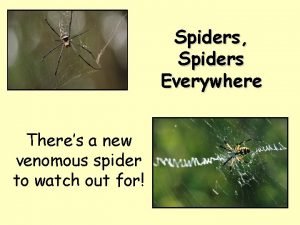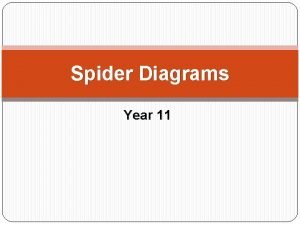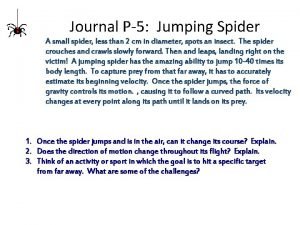Spider Monkeys Rose Perkins What Spider Monkeys Eat


















- Slides: 18

Spider Monkeys Rose Perkins

What Spider Monkeys Eat 90% fruit seeds Decaying bark Small insects-bugs Bird eggs eat with tails

How They Act Always in trees Rarely come forest floor Travel in bands

Behavior Females-4 years Males 5 years Acrobatic Arm stride 40 ft

Their Habitat High canopy rainforest evergreen rain forest Prefer wet over dry

Types of Spider Monkeys White bellied Brown spider monkey Black headed Brown headed White whiskered

Types of Spider Monkeys Red-faced White cheeked Columbian Yucatan Mexican Ornate Hooded

Reproduction Usually 16 weeks 1 born Hold tails Cling to back

Spider Monkey Skeletons Tails suspend Tails 5 th limb Female 75 -95 cm Male 63 -82 cm Females 42 to 57 in Males 38 to 48 in

Scientific Names Spanish “Mono Araña” Spanish b. h. Ateles fusciceps

Family Names Spider monkey family-Atelidae Spider Monkey subfamily- Alouattinae Spider Monkey Genus- Atelus

Spider Monkey Facts Carnivores Barks, screeches, other sounds Birth every 2 -5 years

More Spider Monkey Facts Are endangered species Tails have a print

Young Spider Monkeys Born no bigger forearm Born little hair

Where? Found Mexico-South Brazil Sounds travel 5 miles

http: //www. macalester. edu/~montgomery/spider monkey. html http: //www. allaboutwildlife. com/monkeys/spidermonkeys/6310 http: //a-z-animals. com/animals/spider-monkey/ http: //www. angrydmonkey. com/interesting-factsspider. html http: //www. heathwood. org/simpson/quicklinks/an imalsoftherainforest/spidermonkey. htm http: //www. ecuadortravel. net/biodiversity. mammals. monkey. htm http: //worldstuff. net/monkeys-jumping-from-treeto-tree. html http: //www. arkive. org/black-handed-spidermonkey/ateles-geoffroyi/video-ve 00. html http: //www. hoglezoo. org/meet_our_animals/anim


 Old vs new world monkeys
Old vs new world monkeys Spider monkey life cycle
Spider monkey life cycle Monkeys eat peeled bananas chemistry
Monkeys eat peeled bananas chemistry Never let monkeys eat bananas
Never let monkeys eat bananas Hobo spider range
Hobo spider range I would rather eat potatoes than to eat rice.
I would rather eat potatoes than to eat rice. I eat, you eat, he eats.
I eat, you eat, he eats. People buy me to eat but never eat me what am i
People buy me to eat but never eat me what am i Defintion of fracture
Defintion of fracture Nc perkins
Nc perkins Uvm landscape change
Uvm landscape change Lars perkins
Lars perkins Bag lunch by dillard perkins
Bag lunch by dillard perkins The yellow wallpaper introduction
The yellow wallpaper introduction Perkins 4008-30tag2 technical data
Perkins 4008-30tag2 technical data Late complications of fractures
Late complications of fractures Perkins geology museum
Perkins geology museum Safa freedom rides
Safa freedom rides 4 r's of fracture management
4 r's of fracture management


































